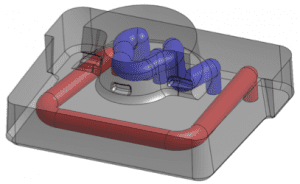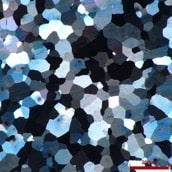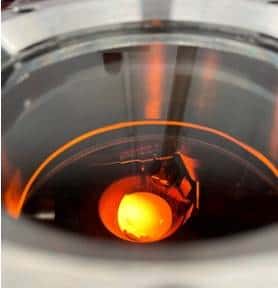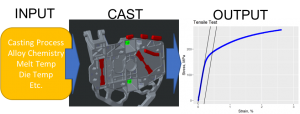Funded by ACRC Consortium






Funded by Federal Agencies

Overview
This project will reduce costs and lead times for DLA / DoD procurements through improvements in the additive manufacturing of tooling for metal mold process parts. Develop and qualify additive manufacturing design guidelines, processes, and materials for fabrication of rapid tooling, including tooling with conformal cooling lines.
Researchers: C. Soderhjelm, D. Apelian

Category: Funded by Federal Agencies

Increasing demand of aluminum die castings in structural and other applications are increasing due to their great performance to cost ratio. However, for the technology to stay relevant it has to keep up with the increasing demands, financial and technological, of the manufactured components. Superior properties and cycle times can be achieved by improving the thermal management during die casting of aluminum alloys. Heat extraction from the casting is key to achieve optimized castings at a higher cycle rate. Conformal cooling channels within the dies and its tools has the potential to create uniform and more efficient heat extraction. However, the complex geometries of that go hand in hand with conformal cooling channels are expensive and, in some cases, impossible to manufacture.
One of the great advantages of many additive manufacturing processes is the design freedom it offers. Building components from the bottom up, layer by layer, allows for the creation of complex shapes which would be impossible to make with traditional manufacturing methods. The flexibility of the additive manufacturing processes allows for possible reductions in both cost and lead times for tooling for the die casting industry.
A total of five die casting tools, such as cores and inserts, will be identified to be used for the qualification of additive manufacturing processes and materials. Successful results are considered when the lead time for manufacturing the tools is reduced from weeks to days and the tool life is comparable to the traditional H13 machined tools. From the work described below a set of guidelines for designing tooling with conformal cooling lines will be established.

Overview


Ultimately, this effort will reduce logistical issues by enabling the reuse of waste iron, prove the feasibility of field-capable manufacturing, reduce equipment down-time, and increase operational readiness.
Category: Funded by Federal Agencies

There is a need to improve the material sustainability of the warfighter. Currently, forward operating bases (FOB) produce an abundant amount of ferrous (iron) waste, which cannot be removed due to security reasons and local infrastructure constraints. However, an agile manufacturing process enables the reuse of scrap metal to produce needed parts for the warfighter.
Three manufacturing stages are addressed:
(1) quality control of the feedstock scrap material
(2) a stereolithography (SLA) enabled investment casting (IC) process, and
(3) post-process heat treating.

Overview


Researchers: C. Crook, L. Valdevit, D. Mumm, D. Apelian
Category: Funded by Federal Agencies


Traditionally used as a coating and repair process, cold spray is a promising technology expanding in the field of additive manufacturing (AM). Unlike laser-based AM processes, cold spray is a solid-state process, making it extremely advantageous for processing refractory metals and enables the retention of the powder feedstock’s microstructure. Cold spray also features minimal oxidation, particularly as parts can be sprayed in carrier gases like nitrogen or helium.
However, cold spray is incredibly sensitive to powder feedstock quality and processing parameters. Various effects of powder morphology, powder production method, and spray parameters on the resultant deposit are not yet well understood. Through investigating various cold spray processing conditions and powder feedstock processing methods, this research aims to establish clear processing-microstructure-property relationships to enable the tailoring of cold spray AM processing for refractory alloys.
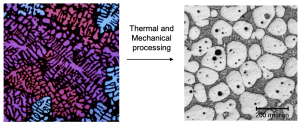
Wire Arc Additive Manufacturing
Researchers: J.G. Webster, C. Soderhjelm, D. Apelian
The total aluminum content per vehicle is expected to increase significantly over the next decade due to electrification of the automotive industry. Presently, the most industrially deployed and cost-effective process to accommodate this demand for light alloy components is high pressure die casting (HPDC). Gigacasting is a recent process advancement building off HPDC that has allowed for the consolidation of multiple car parts into one large structural casting, improving manufacturing efficiency through the reduction in machining, post-processing assembly, and vehicle weight. The limiting factor in expansion of this technology is the tooling needed for continuous casting of larger components with varying thicknesses; localized control of heat is required to achieve uniform structural properties throughout the part without compromising cycle time or die life. Metal additive manufacturing (AM) is a pathway that can be exploited to generate complex tooling architecture that is otherwise not accessible with conventional subtractive fabrication systems.
Wire-arc additive manufacturing (WAAM) is a promising candidate to produce large-scale tooling integrated with novel thermal management technologies, such as conformal cooling and heating channels that contour the cast part. This route offers several advantages as compared to more conventional AM processes:
- Increased deposition rate
- Inexpensive feedstock
- Higher energy efficiency
- Larger build volume
Furthermore, the ability of WAAM to produce near-net shape components can improve material utilization and promote a single-line manufacturing system for the rapid production of casting dies. The process utilizes a welding heat source (GMAW, GTAW, or PAW) coupled with a robotic arm or CNC gantry to continuously deposit molten metal layer-by-layer into the desired geometry based on a 3D CAD file. A wide variety of welding wire alloys can be used as feedstock, which are inexpensive and require less consideration as compared to powders. Shielding gases are employed rather than a constrained build chamber to protect the weld pool from atmospheric contamination.
Due to the complex thermal cycles experienced by previously deposited layers during processing as well as rapid solidification rates inherent to WAAM, traditionally deployed tool steels are often printed with heterogeneous microstructures, high residual stresses, and defects that negatively impact the performance of the die. Unlike wrought steel blocks, there are currently no standards for post-processing treatments in AM to tailor the mechanical properties or address these issues. The current objective of this work through the ACRC is to leverage process improvements such as metal cored-wire feedstock additions for cold metal transfer (CMT) based WAAM and study the post-processing steps required to make these materials amenable to the tooling conditions of die casting.
Figures

Figure 1. Schematic diagram of a GMAW based Wire-Arc Addive Manufacturing system (Source: Xia, C. et al. A review on wire arc additive manufacturing: Monitoring, control and a framework of automated system. Journal of Manufacturing Systems 57, 31–45 (2020))

Figure 2. High speed camera footage of droplet detachment during cold metal transfer (CMT) welding, which is based off a modified GMAW process. (Source: www.fronius.com)
Funded by Industry

Overview

The twin defect region is examined by structural, chemical and electrical characterization in heavily doped silicon crystals, which twinned during growth. Twin formation theories are examined and tested against the new measurements.
Researchers: J. Kearns, D. Apelian
Category: Funded by Federal Agencies

Advanced, low voltage power control electronics are needed to enable low power consumption computers, telecommunications and automotive devices. Lower voltage power electronics are made from dislocation-free silicon heavily doped with arsenic or antimony to provide extremely small electrical resistivity. As crystal resistivities have been lowered to attempt to achieve lower power losses, twinning of the crystal has unexpectedly occurred during growth, so that the crystal no longer possesses the required crystallographic orientation for device function. The purpose of this project is to determine the mechanism of twin formation, so that crystal growth process conditions can be designed to eliminate this defect and allow lower resistivity crystals to be grown reliably.
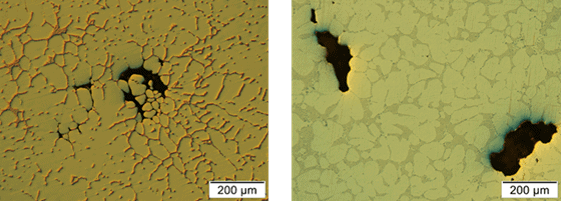
Overview

The aim of this project is to investigate those phenomena in Al-alloys and establish a deeper understanding of the solidification dynamics; this will enable us to better predict the location of defects in castings.
Researchers: A. Jean-Philippe, H. Brody (UCONN), D. Apelian
Category: Funded by Industry


